Justice is Blind in Paper Money Decision
In a decision that could be called "What is the shape of your money," U.S. District Judge James Robertson handed the Treasury Department an order that bills should be designed for the good of all. In a "sharp" opinion based on the Rehabilition Act and not the ADA, folks will be wondering how having U.S. Dollers being of equal size could be an inequality to anyone. This decision has already revealed the divisions within the "disability rights" world, as the Nattional Federation for the Blind cringes in fear, while the American Council for the Blind leads the way to a revolution in the design of the green-back, but not the "dollar."
As you can see, above, or, if you are vision impared, not see very well, one denomination looks like another in US paper money, unlike the paper money of most other countries. In countries I have traveled to, the shape, size and colour of money differs, making it easy to quickly identify the bill to use to pay for goods and services. It makes it easy, especially for those of us who were not raised in a country that uses the metric system. It sure is hard to read that 1 million printed on the bill in a different language, and I cannot imagine how long it would take to buy a newspaper if I had to count all those zeros! So, if the US does resize the All American Dollar, we will all benifit, as will all tourists, and, oh, by the way, folks who are blind will not have to depend on the kindness of strangers.

Of course there will be those who fear what this change in the shape of the green back will "mean." The American Council of the Blind claims it will give meaningful access to money for those who are blind, or visually impaired, affording them the same independence we all take for granted. Then there are those who have immediately opposed this decision based on the percieved "politics" of the Judge, after all, he was the judge who quit in protest over secret wiretaps by the current Bush Administration. The Government will probably think it means a huge jump in cost for them, but when has that ever deterred the government? Vending machine designers will discover it will not require the redesign of all vending machines, since no one is suggesting that the 1 dollar bill be changed in any way. Oh, well, perhaps folks who want the 1 dollar bill to go away will find some meaning in this decision?
Then there is the interesting stance of the National Federation of The Blind, who states in their press release that this decision is clouding the issue, which is not that the blind cannot redily tell a 1 dollar bill from a 20, but that blind folks are not getting the jobs they deserve. It is the earning of money, and not the making of money that should be the focus of advocasy for the blind, according to the Federation. The Federation claims in one place in their press release that 70% of those (blind) who want to work cannot find employment and therefore do not see money. They fear that if employers get the idea that blind folks cannot see documents they will request all kinds of "accomodations" and so they believe this decision will result in blind folks finding it hard to get a job. Then they state that blind folks who have jobs can ask for all kinds of accomodations to do their jobs, because they cannot see documents.
The interesting issue here is the federation continues to support the blind as dependent (upon them?) upon others, and fears levaling the playing field so the blind are not like little children asking everyone they do business with to pick out the right money, and count back the right money. Remember what a sense of independence, of "feeling grown up", it was when you finally caught on to the "meaning of money." So too, blind folks will be changed by this one step into "adult-hood" by becoming independent from the good will of others during the exchange of goods for money. While the Federation worries about folks having "pity" for the blind, this decision actually removes the need for the blind to ask for pity, or for strangers to count their change for them.
It is high time for the entrenched institutions who have been advocating for PWD's to take the next step, into the world of helping their charges become independent members of the community, well able to contribute acording to their actual abilities. The mark of a good "teacher" is to have the pupil "graduate."
PS: On my Christmas wish list is a square, pink 20 dollar note!
Giving Thanks
 What A Sweety!
What A Sweety! Time to give thanks for the wonderful gifts we have recieved this past year. First, I wish to thank the Whites for giving me their beautiful purebred Siberian Husky, White's Shannon. Thank you White family, Shannon has been a dream come true.
 Here is Shannon fooling around. She is just being silly. I had my hands full training her, as she was just two years old and full of Husky spirit. The "trick" is to train her without breaking her spirit. The best book I know about taining, or teaching, for that matter, is Smokey, The Cow Horse. Shannon is quite submissive for a Husky, and an eager learner. She is willing to work hard to learn what is allowed, and not allowed, and when she is "working" and when it is OK to just be silly. I have trained animals before, and trained thouroghbred race horse, so the training skills are well known, but the transmission of "working together as partners" is most important.
Here is Shannon fooling around. She is just being silly. I had my hands full training her, as she was just two years old and full of Husky spirit. The "trick" is to train her without breaking her spirit. The best book I know about taining, or teaching, for that matter, is Smokey, The Cow Horse. Shannon is quite submissive for a Husky, and an eager learner. She is willing to work hard to learn what is allowed, and not allowed, and when she is "working" and when it is OK to just be silly. I have trained animals before, and trained thouroghbred race horse, so the training skills are well known, but the transmission of "working together as partners" is most important.
I want to thank my dear friend and neighbor for taking me to pick up Shannon, and helping me to train her, and going for walks together.
 I want to thank all those who worked over the years to create a "dog park." Thanks to Skip Schloming, for his advice and support, and most especially, to the Cambridge Historic Commission for modifying their policies to accomodate a Dog Park at the most wonderful Fort Washington Park! All the dogs love it! Here is a shot of Shannon on the embankment with our Colours flying proudly above.
I want to thank all those who worked over the years to create a "dog park." Thanks to Skip Schloming, for his advice and support, and most especially, to the Cambridge Historic Commission for modifying their policies to accomodate a Dog Park at the most wonderful Fort Washington Park! All the dogs love it! Here is a shot of Shannon on the embankment with our Colours flying proudly above.
Hope your day is filled with wonders to be thankful for, too. Take care, Shannon and Kathy
She is unable to reach the buzzer!

Boston police officer, on construction detail, responds to MBTA Bus #2224, route 66 on Harvard St at Brighton. The bus driver ordered the police officer to arrest a passenger for taking a photo inside the bus. When the Boston police officer declined to do so, I heard the bus driver tell the police officer, "But is's against the law! You have to arrest her." The police officer walked away shaking his head.
Previously this year, during a meeting/hearing of the Transportation Committee Chaired by Craig Kelley, to discuss with MBTA officials MBTA policies and transportation issues in Cambridge Ma, T officials responded to a question about their policies regarding taking photos. The response was that the T's policy for inside "train/trolly" stations, and tunnels, if they see a passenger taking a photo, they ask the person to stop taking photos. One can apply for a permit if they have a video project. The T official continued to state that the T has no policy regarding taking photos at bus stops nor on busses. The police inform me that it is not against any law to take photos. It is common to see folks on busses take photos inside the bus, sometimes of the scenery as they drive by, and sometimes of people inside the bus. many use their cell phone cameras for this. Many folks have taken photos to document continued violations of the ADA regarding access for persons with disabilities who want to use the T.
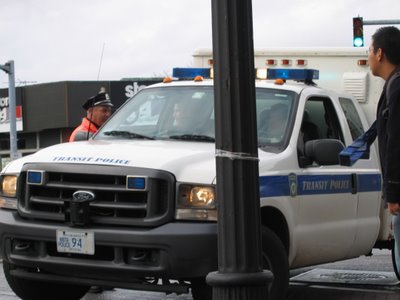 Then After the Boston Police Officer left and went back to his "detail" duty, the bus driver called for MBTA police, but failed to tell his supervisor what this was all about. What had happened is an old lady called out to the driver to stop the bus, (so she could get off) and the driver yelled at her "I am not going to stop if you don't press the buzzer!!" She called out again, urgently, "stop the bus, stop the bus!" The bus driver screamed at her that she had to press the buzzer, or he wasn't going to stop. Another passenger called out to the driver "She is unable to reach the buzzer." The bus driver then directed a liteny of abuse at the passenger that tried to help the old lady. The passenger then took a photo of the sign inside the bus, identifying the bus number. When the T Police arrived, did the bus driver tell them what happened? Or did the bus driver describe a half-crazed disruptive terrorist suspect? The T police arrived with a "police wagon" to arrest the passenger, and the passenger called the office of the Attorny General, informing the T Police she was doing so. The T Police became angry, grabbed the cell phone and the two hands of the passenger together in his hands, dragged her down the isle of the bus to the rear door, and pitched her out to the sidewalk, where she landed on her hip. Exiting the bus, the T Police said, "Nice fall you had there!" and walked back and got into the "Police wagon." The photo above shows the Boston Police and the T police in conversation while the passenger lies on the sidewalk. Everyone drives away, and the Boston Police Officer returns to "duty" in the intersection. Passenger lies on sidewalk for over a half hour, calls 911 for help, and pedestrians come to her aid, until ambulence finally comes.
Then After the Boston Police Officer left and went back to his "detail" duty, the bus driver called for MBTA police, but failed to tell his supervisor what this was all about. What had happened is an old lady called out to the driver to stop the bus, (so she could get off) and the driver yelled at her "I am not going to stop if you don't press the buzzer!!" She called out again, urgently, "stop the bus, stop the bus!" The bus driver screamed at her that she had to press the buzzer, or he wasn't going to stop. Another passenger called out to the driver "She is unable to reach the buzzer." The bus driver then directed a liteny of abuse at the passenger that tried to help the old lady. The passenger then took a photo of the sign inside the bus, identifying the bus number. When the T Police arrived, did the bus driver tell them what happened? Or did the bus driver describe a half-crazed disruptive terrorist suspect? The T police arrived with a "police wagon" to arrest the passenger, and the passenger called the office of the Attorny General, informing the T Police she was doing so. The T Police became angry, grabbed the cell phone and the two hands of the passenger together in his hands, dragged her down the isle of the bus to the rear door, and pitched her out to the sidewalk, where she landed on her hip. Exiting the bus, the T Police said, "Nice fall you had there!" and walked back and got into the "Police wagon." The photo above shows the Boston Police and the T police in conversation while the passenger lies on the sidewalk. Everyone drives away, and the Boston Police Officer returns to "duty" in the intersection. Passenger lies on sidewalk for over a half hour, calls 911 for help, and pedestrians come to her aid, until ambulence finally comes.
All Shook Up!
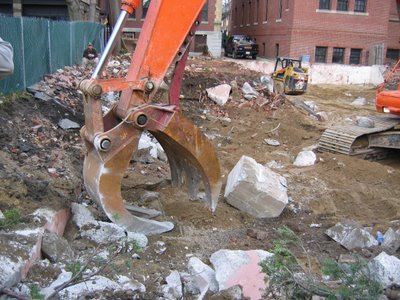 Now that is a good sized claw!!
Now that is a good sized claw!! As you can see, the major part of the convent is down. Work is progressing with the removal of the foundation. As the development of Blessed sacrament continues, neighbors remain concerned about "colateral" damage to their own properties or to their health.
As you can see, the major part of the convent is down. Work is progressing with the removal of the foundation. As the development of Blessed sacrament continues, neighbors remain concerned about "colateral" damage to their own properties or to their health.
 Today at aprox 2:30pm, folks were tossed from thier homes by the strong shaking of their foundations. I expierenced this problem before, during the razing and construction of Valentine Place. The City claims that no one's homes should suffer shaken house syndrome because there is no bedrock here in Cambridgeport, its all sand and clay. Well, that is the problem, as anyone can understand when one considers the widespread severe damage caused by earthquakes in Mexico City which is also built on sand. another neighbor and myself spoke with the developer, and I have been assured they will try alternative techniques for excavating the foundation. The shakin' has stopped, at least for now.
Today at aprox 2:30pm, folks were tossed from thier homes by the strong shaking of their foundations. I expierenced this problem before, during the razing and construction of Valentine Place. The City claims that no one's homes should suffer shaken house syndrome because there is no bedrock here in Cambridgeport, its all sand and clay. Well, that is the problem, as anyone can understand when one considers the widespread severe damage caused by earthquakes in Mexico City which is also built on sand. another neighbor and myself spoke with the developer, and I have been assured they will try alternative techniques for excavating the foundation. The shakin' has stopped, at least for now.
Who is included as members of the community?

 This is the location of the first Green Port meeting. As you can see there is a formidible physical barrier for PWD's for whom climbing steps is not possible. In addition, PWD's acompianied by their service dogs are not welcome as this is an "animal free" home. It is interesting to note that the Dana Park Neighborhood Association used to meet in private homes like this until I raised serious objections. Now called Cambridgeport Neighborhood Association, meetings are held in accesible locations, often in the community room of Woodrow Wilson Court.Steve, of Green Port, wrote after the first meeting..."We brainstormed ideas for how Cambridgeport could come together as a community to support individual choices and shared actions to reduce greenhouse emissions and move us toward using renewable energy"Steve also provided a ride for me to the meeting, and home again, because I was informed that I could not have my service dog accompiany me. I have asked both Bill, the president of the CNA and Steve, to relocate these meetings for the future, so PWD's will not feel unwelcome and be excluded. Therefore, I ask, who are members of the community? Who is considered a neighbor? Who should be excluded from membership? Attendence? Meaningful access? Should Cambridgeport Neighborhood Association allow PWD's to be excluded from full and equal participation by choosing to hold meetings in inaccessible spaces? Should Cambridgeport Neighborhood Association lend support to "other groups" who exclude some neighbors, some community members, based on their disability, from attending meetings because the location selected for the meeting is inaccessible?
This is the location of the first Green Port meeting. As you can see there is a formidible physical barrier for PWD's for whom climbing steps is not possible. In addition, PWD's acompianied by their service dogs are not welcome as this is an "animal free" home. It is interesting to note that the Dana Park Neighborhood Association used to meet in private homes like this until I raised serious objections. Now called Cambridgeport Neighborhood Association, meetings are held in accesible locations, often in the community room of Woodrow Wilson Court.Steve, of Green Port, wrote after the first meeting..."We brainstormed ideas for how Cambridgeport could come together as a community to support individual choices and shared actions to reduce greenhouse emissions and move us toward using renewable energy"Steve also provided a ride for me to the meeting, and home again, because I was informed that I could not have my service dog accompiany me. I have asked both Bill, the president of the CNA and Steve, to relocate these meetings for the future, so PWD's will not feel unwelcome and be excluded. Therefore, I ask, who are members of the community? Who is considered a neighbor? Who should be excluded from membership? Attendence? Meaningful access? Should Cambridgeport Neighborhood Association allow PWD's to be excluded from full and equal participation by choosing to hold meetings in inaccessible spaces? Should Cambridgeport Neighborhood Association lend support to "other groups" who exclude some neighbors, some community members, based on their disability, from attending meetings because the location selected for the meeting is inaccessible?
Seeing the light

Here are a couple of compact flourescents that you may have heard about. This is one design out of many. Some have a squiggly shape, some look like regular light bulbs, and some are elaborate ceiling fixtures, enclosing compact flourescents specifically for mounting to replace your "old" flourescent fixture. Some older fixtures may have difficulty accepting some of these new compacts, so try several designs until you get one that fits. I switched to compacts many years ago, and have seen great progress in their design. I have four rooms, two lavs and a basement and use 15 compacts.
The main reason I switched was for energy savings. The compacts use less energy, therefore are less expensive to use. Folks also point out they are good for the environment. Councilor Henrietta Davis has informed us that N-Star has a program where they give compact lights free to schools for groups like the boy scouts to sell for $3.00 each. Sue Butler of Green Decade informed us they can be purchased for $0.99.
I have repetedly requested that these environmentally friendly energy savers be given free to seniors and PWDs living on extreemly low, fixed income. They could be distributed through programs we have already established, such as the Food Pantry at the Senior Center, the City's Snow Exemption Program, and the Fuel Assistance Program. All three of these programs screen folks, so folks who qualify for these programs should recieve free compacts so we can all practice energy saving, environmentally friendly reading.
The Peace Of Wild Things
 When despair for the world grows in me
When despair for the world grows in me
And I wake in the night at the least sound
In fear of what my life and my children’s lives may be,
I go and lay down where the wood drake
Rests in his beauty on the water, and the great heron feed.
I come into the peace of wild things
Who do not tax their lives with forethought
Of grief. I come into the presence of still water.
And I feel above me the day-blind stars
Waiting with their light. For a time
I rest in the grace of the world, and am free.
Wendell Berry, Openings: The Peace of Wild Things
Acknowledging, Honouring and Thanking our Heros!
 On this Veteran's Day, November 11, 2006, fromtheport wishes well for veteran's and their familes, and the new Veteran's Pride Initiative, to remind American's of the pride and homour in the hearts of those who have served.
On this Veteran's Day, November 11, 2006, fromtheport wishes well for veteran's and their familes, and the new Veteran's Pride Initiative, to remind American's of the pride and homour in the hearts of those who have served.
For my friend Don
First attempt? 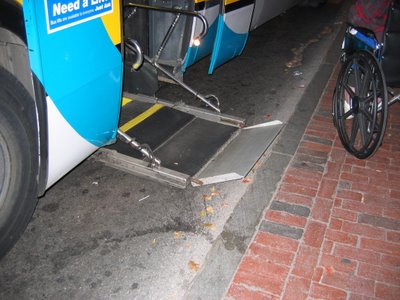 Second attempt??
Second attempt?? These photos show a person in a wheel chair being humiliated because the MBTA bus driver is too lazy to curb the bus. Central square, Mass Ave at Pearl St, #1 bus to Dudly. 10/26/06 6:08 pm.
These photos show a person in a wheel chair being humiliated because the MBTA bus driver is too lazy to curb the bus. Central square, Mass Ave at Pearl St, #1 bus to Dudly. 10/26/06 6:08 pm.
Cambridge City Council
 September 25, 2006 Cambridge City Council on stairway to third floor where the City's in house law department employes eight attornies. The entrances to Sullivan Chamber are to the right. From left to right...first row, Councilor Michael Sullivan, past mayor for four years, Clerk of Courts elect, Michael's twin brother, Walter, is a Mass Commission Against Discrimination Commissioner; Councilor Brian Murphy, who sits on the far right side first desk nearest the back wall in Sullivan Chamber; Councilor Denise Simmons; City Clerk Margaret Drury, parlimentarian; Councilor Henrietta Davis; Councilor Marjory Decker, who sits at nearest public entrance to Sullivan Chamber; Councilor Anthony Galluccio.Back row, left to right, Vice Mayor Tim Toomey, also serves as State House Representative; Assistant to City Council Sandy Albano; Mayor Ken Reeves who chairs the City Council Meetings; Deputy City Clerk Donna Lopez; Councilor Craig Kelley.
September 25, 2006 Cambridge City Council on stairway to third floor where the City's in house law department employes eight attornies. The entrances to Sullivan Chamber are to the right. From left to right...first row, Councilor Michael Sullivan, past mayor for four years, Clerk of Courts elect, Michael's twin brother, Walter, is a Mass Commission Against Discrimination Commissioner; Councilor Brian Murphy, who sits on the far right side first desk nearest the back wall in Sullivan Chamber; Councilor Denise Simmons; City Clerk Margaret Drury, parlimentarian; Councilor Henrietta Davis; Councilor Marjory Decker, who sits at nearest public entrance to Sullivan Chamber; Councilor Anthony Galluccio.Back row, left to right, Vice Mayor Tim Toomey, also serves as State House Representative; Assistant to City Council Sandy Albano; Mayor Ken Reeves who chairs the City Council Meetings; Deputy City Clerk Donna Lopez; Councilor Craig Kelley. Hallway around the corner from the stairway where City Council posed, looking into the "green room" entrance to Sullivan Chamber used by City Councilors. There is actually a second small room in the back which is entered through a door to the right of the table and chairs, but which cannot be seen in this photo. Food is served here, during meetings, and councilors "hang out" while City Council meetings are in session. There is a monitor they use to watch the meeting.
Hallway around the corner from the stairway where City Council posed, looking into the "green room" entrance to Sullivan Chamber used by City Councilors. There is actually a second small room in the back which is entered through a door to the right of the table and chairs, but which cannot be seen in this photo. Food is served here, during meetings, and councilors "hang out" while City Council meetings are in session. There is a monitor they use to watch the meeting.
There is as you can see a bench in the hallway, which faces the public entrance/door to Sullivan Chamber, to the right of the piano. This space is constantly busy during meetings, as both City Councilors, and the public "caucus" here, and news reporters interview folks.
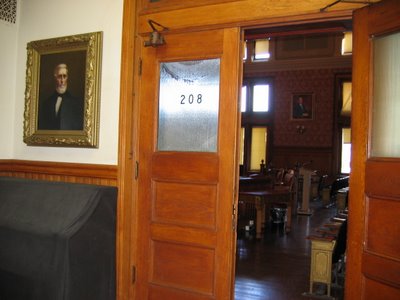 Public entrance to Sullivan Chamber showing public seating area. There is a break in the fence between the public seating, and the City Council "chamber" nect to the podium in the middle. This door is across from the bench shown in the previous photo, and ajacent to the Mayor's office to the right.
Public entrance to Sullivan Chamber showing public seating area. There is a break in the fence between the public seating, and the City Council "chamber" nect to the podium in the middle. This door is across from the bench shown in the previous photo, and ajacent to the Mayor's office to the right.
Inside Sullivan Chamber
 View of City Council meeting, taken Monday Nov 6. Mayoy ken Reeves is chairing the meeting. You can just see the heads of two city councilors seated to the right. Other councilors are in the "green room" that you can see on the far left, beyond the flag. The railing, of fence, divides the public seating from the City Council "chamber."
View of City Council meeting, taken Monday Nov 6. Mayoy ken Reeves is chairing the meeting. You can just see the heads of two city councilors seated to the right. Other councilors are in the "green room" that you can see on the far left, beyond the flag. The railing, of fence, divides the public seating from the City Council "chamber."
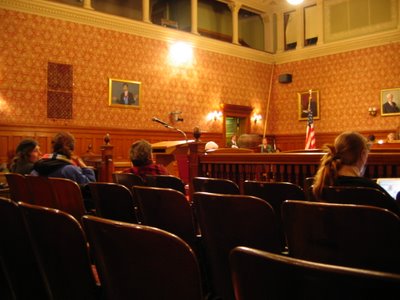 Here is a view that shows the podium where some stand to give testimony, and just in front is a table where some sit to give testimony. In this photo we can just barely see the top of the head of the City Manager. On the far left are desks where 4 more city concilors sit. There are also seats along the back wall. I see someone entering from the "green room" and perhaps that is Councilor Decker between the green room and flag.
Here is a view that shows the podium where some stand to give testimony, and just in front is a table where some sit to give testimony. In this photo we can just barely see the top of the head of the City Manager. On the far left are desks where 4 more city concilors sit. There are also seats along the back wall. I see someone entering from the "green room" and perhaps that is Councilor Decker between the green room and flag.
 Here is a view, from where I was seated throughout the meeting, of the entrance/exit to Sullivan Chamber. The seats are quite comfortable for me to sit in. However it is difficult to "slide" in so far down the ilse, and when many folks are in attendence, it requires folks "crawling over one another. i normally prefer to sit near the door, where I can get up and walk out side and back so I am not sitting too long. There are two unobstructed seats over there, one in the back which is also used by others with mobility disabilities, and the few seats to the right of this door, where there is also a great space for my service animal. You can just barely see those seats in this photo. The problem with sitting there is that Councilor Decker is seated at the desk colsest to the railing, so this seat would place my service animal within 10 feet of her. On Oct 16, outside of Sullivan Chamber, Sandy asked me if I would be willing to move my seat to the far side, due to Councilor Decker had not taken her allergie medicine that evening. I agreed immediately, and have sat in the back ever since.
Here is a view, from where I was seated throughout the meeting, of the entrance/exit to Sullivan Chamber. The seats are quite comfortable for me to sit in. However it is difficult to "slide" in so far down the ilse, and when many folks are in attendence, it requires folks "crawling over one another. i normally prefer to sit near the door, where I can get up and walk out side and back so I am not sitting too long. There are two unobstructed seats over there, one in the back which is also used by others with mobility disabilities, and the few seats to the right of this door, where there is also a great space for my service animal. You can just barely see those seats in this photo. The problem with sitting there is that Councilor Decker is seated at the desk colsest to the railing, so this seat would place my service animal within 10 feet of her. On Oct 16, outside of Sullivan Chamber, Sandy asked me if I would be willing to move my seat to the far side, due to Councilor Decker had not taken her allergie medicine that evening. I agreed immediately, and have sat in the back ever since.
Councilor Decker presents City's appreciation to Fred Reece

Marjory did Fred right by speaking extensively about his many contribitions to the community over the years. This was taken during the September 14th meeting of Cambridgeport Neighborbood Association, previously known as the Dana Park Neighborhood Association.
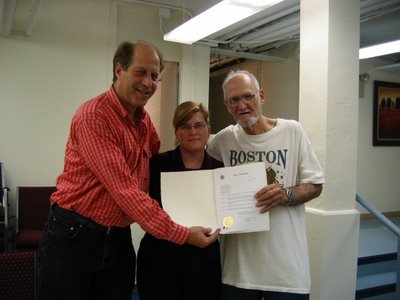 Here you can see where we meet. It is in the community room at Woodrow Wilson Court. Although the room is small, it is "handicapped" accessible, with a ramp to the right of the stairs you see to the right.
Here you can see where we meet. It is in the community room at Woodrow Wilson Court. Although the room is small, it is "handicapped" accessible, with a ramp to the right of the stairs you see to the right.
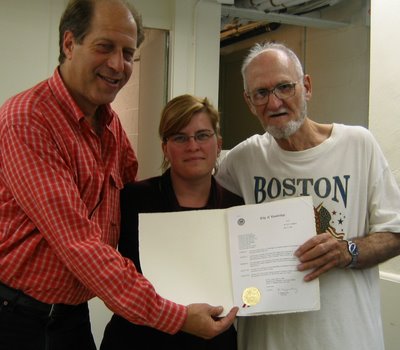 Here, from left to right, is Bill August, president Cambridgeport Neighborhood Association, Marjory Decker, City Councilor, and Fred Reece. Fred is president of Woodrow Wilson association, and continues to be active in our community. They are displaying a suitibally engrossed copy of the City's appreciation.
Here, from left to right, is Bill August, president Cambridgeport Neighborhood Association, Marjory Decker, City Councilor, and Fred Reece. Fred is president of Woodrow Wilson association, and continues to be active in our community. They are displaying a suitibally engrossed copy of the City's appreciation.
What's wrong with this picture?
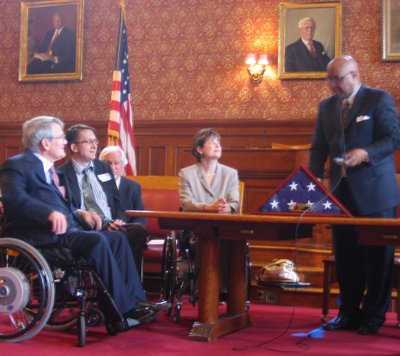 Not sure if I can remember everyone's names, here, I'll do my best. From left to right, Gentleman from National Organization on Disability; Michael Muehe, ADA coordinator, City of Cambridge; President, MIT; Nancy Starnes, national Organization on Disability, all seated, and standing mayor Ken Reeves. This is my photo of the Mayor of Cambridge accepting the $25, 000 "prize" for winning NOD's Accessible America grand prize award in a special ceremony held in Sullivan Chambers, City Council meetings are held there, on June 12, 2006. We have asked to see, but have not been shown, application the City submitted for this award, which says that the City of Cambridge if the most accessible City in America, and should serve as a model for other cities.?Members and supporters of the disability advocasy group I founded, Citizens for Feasable Compliance, wore question marks to the ceremony, and passed out our press release.Here is my question to you, and please feel free to answer...What is wrong with this picture?
Not sure if I can remember everyone's names, here, I'll do my best. From left to right, Gentleman from National Organization on Disability; Michael Muehe, ADA coordinator, City of Cambridge; President, MIT; Nancy Starnes, national Organization on Disability, all seated, and standing mayor Ken Reeves. This is my photo of the Mayor of Cambridge accepting the $25, 000 "prize" for winning NOD's Accessible America grand prize award in a special ceremony held in Sullivan Chambers, City Council meetings are held there, on June 12, 2006. We have asked to see, but have not been shown, application the City submitted for this award, which says that the City of Cambridge if the most accessible City in America, and should serve as a model for other cities.?Members and supporters of the disability advocasy group I founded, Citizens for Feasable Compliance, wore question marks to the ceremony, and passed out our press release.Here is my question to you, and please feel free to answer...What is wrong with this picture?
Service Animals Banned In Cambridge City Council??
Below is a copy of the letter I wrote to Michael Muehe, complaining about the harrassment, retaliation, coertion, intimidation and threats of arrest because I chose to exercise my civil rights, and attend the City Council meeting, Monday evening, Oct 30, 2006, along with other members of the public. I have been attending these meetings for over 5 years now, and without any problems.
Where is the outrage for this demeaning bigotry, this hateful behavior? Am I an object to be ordered about by arragant out of control City Councillors? Shall the Mayor ignore the cry for help from a member of the public when he fails to control the City Councilors during the business of City Council he is chairing? Would he have called for the police to arrest a person of colour, a gay, a woman, a Jey, that was ordered to leave in violation of their civil rights? why does he believe that when a person with a disability acompianied by their service animal exercises their civil rights it is a "sense of entitlement?"
These are intolerable acts!
Michael Muehe, ADA coordinator, City of Cambridge, MA.
During the City Council meeting last night, I suffered retaliation for exercising my civil right to be accompianied by my service animal.
Concillor Decker, during the City Council meeting, without asking for a recess, rushed across the council chamber and into the public seating area, and demanded I leave the meeting because she claimed my service animal was causing her discomfort due to her allergy, explaining that she had not taken her allergy medication that evening. I declined, and she said she would have me removed. I announced that my civil rights were being violated. The Mayor, Ken Reeves, apparently not understanding what Decker was doing, accused me, and not Decker, of causing a disturbance, and ordered the police be called. (Decker had done this without calling for a recess.)
The police arrived immediately, and Police Commissioner Watson ordered me to leave the council chambers. I refused, and informed him that I had a civil right to be accompianied by my service animal. Watson stated it was not because of the animal, but because I created a disturbance. I responded by informing him of what just happened. Nancy Glower, the City's solicitor, was also informed by me of what Decker had done. I explained that the recess was not called by her until after she had rushed me and demanded I leave, right in the middle of the meeting, and which was the real cause of the disturbance, and which act violated my civil rights. The Animal control unit was called.
Glower returned to the "Green Room" and after a couple min returned (while she was away, the police continued to coerce and intimidate me if front of all present) offering me a choice of "reasonable accomodations." first, I could be placed in a seperate room, with the service animal, and watch the meeting on TV, or two, the dog could be removed to a seperate place, while I would be "allowed" to remain in the public meeting room. I declined, and informed her that this was not an issue of "special accomodations" but that I had a civil right to be accompianied by my service animal in any place the public could go, and I observed many members of the public were present, including black people.
She then, again, told me I had to leave due to Councillor Decker's discomfort due to her allergy. I explained that I was already accomodating Decker's allergy, as requested in the Oct 16th meeting, by sitting on the far side, in the back, near the windows. I again stated that an allergy to animals was not a reason to deny access to PWD's who were accompianied by their service animals. I further explained that only if Decker's allergy was raised to the level of a disability as defined by the Civil Rights Act of 1990, could I be asked to move. I informed Glower that Decker's allergy did not raise to that level because she admitted to me that she was not taking her allergy medication that evening.
Glower left. Decker returned to council chambers and Reeves conviened the meeting, Decker stated she could not remain in the meeting due to her allergy to animals. She left the meeting. Reeves stated that some people feel they are entitled to come to the meetings and do anything they want to do. I stayed.
However, I was publically humilaited, and scared by this ruthless intimidation.
ADA says
1. Allergies are not a basis for denying a PWD to be accompianied by their service animal. Even if Decker's allergy raises to the level of a disability, a person with a service animal cannot be excluded from public meetings, and that sitting away from her is enough of an accomodation.
2. The "reasonable accomodations" offered by the City are not reasonable nor appropiate.
3. If the police do arrest me, they must "allow" my service animal to accompiany me to the jail.
4. This episode is retaliation in response to me exercising my civil rights.



























